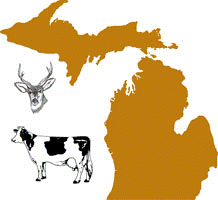Wildlife Disease and Zoonotics
Date of this Version
2003
Abstract
This project looks at whether high case frequency areas or “hot spots” of bovine tuberculosis (tb) exist in free ranging white-tailed deer in northeastern Michigan, and examines the factors associated with them. Michigan Department of Natural Resources researchers have been collecting deer heads annually since 1996 in the five county area of Alcona, Alpena, Montmorency, Oscoda, and Presque Isle as part of an effort to manage an outbreak of bovine tb in the wild white-tailed deer population. From these heads a database containing age, sex, and harvest or collection location information was constructed. The townships within these five counties were categorized as having zero case frequency, medium case frequency, or high case frequency. These categories are based on the number of years at least one tb infected deer was detected in that township.



Comments
A thesis submitted to Michigan State University in partial fulfillment of the requirements for the degree of Masters of Science.